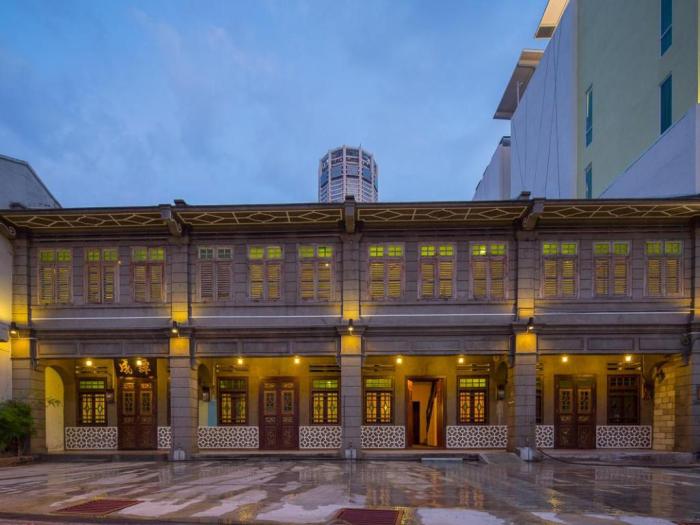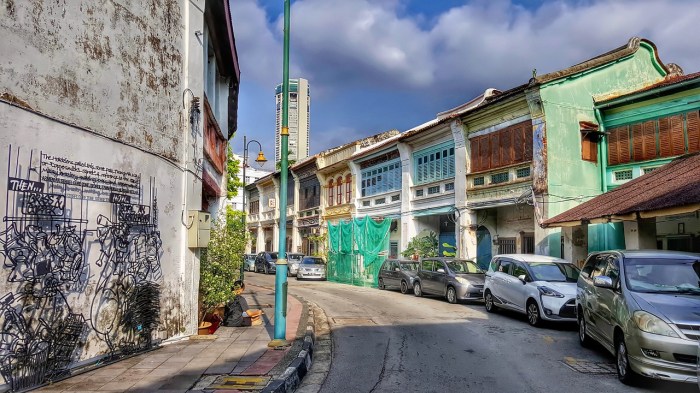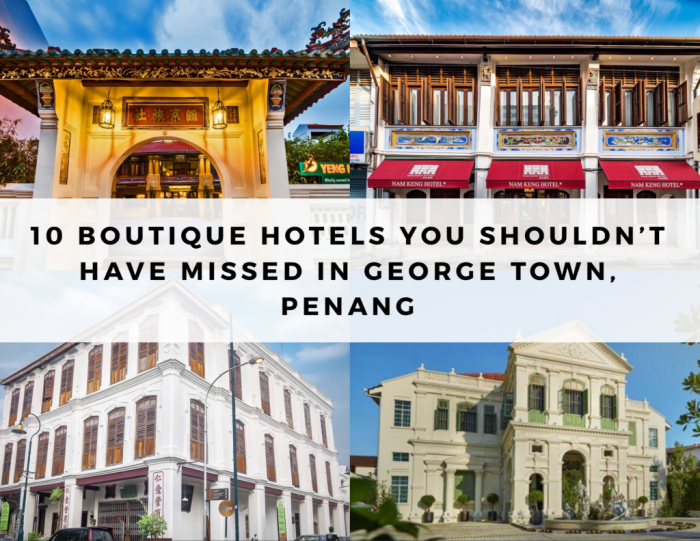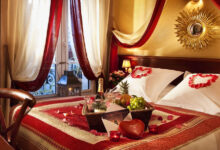George Town Hotels Colonial Charm & Street Art
Hotels in George Town, Penang with colonial architecture and street art offer a unique blend of history and contemporary art. Imagine staying in a beautifully preserved colonial building, waking up to the vibrant colors of street art just outside your window. This isn’t just a stay; it’s an immersion into Penang’s rich cultural tapestry, where history whispers from aged walls and modern creativity bursts onto the streets.
This exploration delves into the fascinating interplay between these two elements, highlighting the hotels that perfectly capture this unique George Town experience.
George Town’s colonial past is vividly reflected in its architecture, showcasing a fascinating mix of British, Chinese, and other influences. These styles evolved over centuries, resulting in a diverse streetscape of grand mansions, ornate shop houses, and charming bungalows. Meanwhile, the city’s street art scene, a relatively recent addition, breathes new life into these historic surroundings, creating a dynamic visual dialogue between past and present.
The hotels discussed here are not just places to sleep; they are living testaments to this captivating blend of history and modern art.
Overview of George Town’s Colonial Architecture

Source: net.my
George Town, Penang’s captivating streetscape is a living testament to its rich colonial past. The city’s architecture, a fascinating blend of styles and influences, reflects centuries of trade, cultural exchange, and power shifts. Exploring these buildings offers a unique glimpse into the history of this vibrant Malaysian city.
Historical Context of Colonial Architecture in George Town
The architectural landscape of George Town is deeply intertwined with its history as a strategic trading port. Established by the British East India Company in 1786, the settlement quickly attracted merchants and immigrants from across Asia and Europe. This influx of diverse cultures profoundly shaped the city’s building styles, resulting in a unique architectural tapestry unlike anywhere else in Southeast Asia.
The initial period saw predominantly utilitarian structures built to accommodate trade and administration, but as the city prospered, more elaborate and decorative buildings were constructed. Later periods saw the incorporation of various architectural styles reflecting the changing tastes and influences from around the globe.
Key Architectural Styles in George Town
George Town’s colonial architecture showcases a remarkable fusion of styles. The most prominent is British colonial architecture, evident in the grand government buildings and elegant shop houses. However, significant Chinese, Indian, and Malay influences are also present, creating a multifaceted and vibrant architectural landscape. These influences are often subtly interwoven within individual buildings, highlighting the complex cultural interactions that shaped the city.
For example, many shophouses blend British colonial structural elements with intricate Chinese decorative details. The incorporation of these various styles is not simply a matter of separate buildings representing distinct cultures; rather, it is often a seamless integration within a single structure, demonstrating the city’s unique history.
Evolution of Architectural Styles Over Time
The evolution of architectural styles in George Town reflects the changing socio-economic conditions and cultural influences over time. Early structures were primarily functional, focusing on practicality rather than aesthetics. As the city’s wealth increased, buildings became more ornate, incorporating elaborate details and decorative elements. The introduction of new building materials and technologies also impacted the architectural styles.
For example, the widespread adoption of concrete in the 20th century led to a shift away from traditional building techniques. This evolution is evident in the diverse architectural styles found throughout the city, from the simple early structures to the more elaborate buildings of later periods.
George Town’s charming hotels, nestled amongst colonial architecture and vibrant street art, offer a unique travel experience. For a completely different vibe, consider the luxurious options in Seoul; if you crave stunning views and impeccable service, check out Luxury hotels in Seoul with panoramic city views and exceptional service. But for a blend of history and modern comfort, Penang’s heritage hotels remain a top choice.
Notable Buildings Showcasing Different Architectural Styles
| Building Name | Architectural Style | Description |
|---|---|---|
| Cheong Fatt Tze Mansion (Blue Mansion) | Chinese Baroque with British Colonial influences | A stunning example of Chinese Baroque architecture with intricate details and a distinctive blue facade. It showcases a blend of Chinese and Western design elements. |
| Khoo Kongsi | Chinese | An elaborate clan house showcasing intricate wood carvings, decorative motifs, and traditional Chinese architectural features. |
| Eastern & Oriental Hotel | Victorian-era British Colonial | A grand hotel exhibiting the elegance of Victorian-era British colonial architecture, with ornate details and a prominent location on the waterfront. |
| Town Hall | British Colonial | A significant example of British colonial architecture, demonstrating the grandeur and formality associated with British government buildings. |
Street Art in George Town

Source: needpix.com
George Town’s vibrant street art scene is a relatively recent phenomenon, yet it has rapidly become a defining characteristic of the city, attracting tourists and inspiring local artists alike. This explosion of color and creativity revitalized neglected corners of the city, transforming them into open-air galleries and contributing significantly to George Town’s unique cultural identity. The movement’s evolution showcases a fascinating interplay between artistic expression, community engagement, and urban regeneration.
Origins and Development of George Town’s Street Art
The rise of street art in George Town can be traced back to the early 2000s, spurred by a growing interest in urban art internationally and a desire to revitalize the city’s aging streetscapes. Initial efforts were often grassroots, with individual artists painting murals on abandoned buildings. However, the momentum significantly increased with the involvement of local communities and the support of the George Town World Heritage Site initiative.
This collaboration fostered a more organized and sustainable approach to street art development, resulting in numerous commissioned works and the creation of designated street art trails. The transformation wasn’t just aesthetic; it also contributed to the economic revitalization of certain areas through increased tourism.
Prominent Street Artists and Their Contributions
While many artists have contributed to George Town’s street art scene, some names stand out for their significant impact and distinctive styles. Many artists remain anonymous, however, their works are integral to the city’s visual tapestry. The collaborative nature of the movement often means that specific attributions are difficult to definitively trace, with many murals representing the work of groups or evolving through multiple artistic hands over time.
The focus on community engagement often overshadows individual recognition, reflecting the collective spirit behind the art’s creation.
Themes and Styles in George Town’s Street Art
The themes explored in George Town’s street art are diverse, reflecting the city’s rich history, multicultural heritage, and contemporary life. Common motifs include depictions of traditional Chinese opera characters, scenes from everyday life, whimsical characters, and abstract designs. Styles range from photorealistic portraits to bold, graphic illustrations and intricate 3D murals. Many artworks incorporate elements of the city’s colonial architecture and street life, creating a visual narrative that blends past and present.
The use of vibrant colors is a consistent feature, adding to the energy and vibrancy of the streets.
Examples of Iconic Street Art Pieces
The sheer volume of street art in George Town makes it difficult to select just a few, but these examples highlight the diversity and impact of the art.
- Artist Unknown: The Children on Bicycle
-Located near Armenian Street, this mural depicts a group of children riding bicycles, capturing a moment of childhood innocence against the backdrop of George Town’s colonial architecture. The vibrant colors and playful composition make it a popular photo spot. - Ernest Zacharevic: Little Girl on a Bicycle
– Possibly the most famous street art piece in George Town, this mural features a little girl reaching out to touch a bicycle on a wall. Its interactive nature invites viewers to become part of the artwork. Located on Armenian Street. - Artist Unknown: The Cat Mural
-This whimsical mural, featuring a large, cartoonish cat, can be found on Lebuh Chulia. Its playful design and bright colors add a touch of whimsy to the street. - Artist Unknown: The Street Scene with Trishaw
-This mural, often found on side streets, depicts a typical street scene in George Town, including a trishaw and local characters. The detail and realism create a snapshot of daily life. - Artist Unknown: The Mural Depicting Traditional Chinese Opera Masks
-This piece, located in a less touristy area, features intricate and colorful depictions of traditional Chinese opera masks, showcasing the city’s cultural heritage. The level of detail is remarkable.
Hotels Showcasing Colonial Architecture
George Town, Penang, boasts a rich tapestry of colonial architecture, and many hotels have cleverly incorporated these historical structures into their offerings, providing guests with a unique and immersive experience. Staying in one of these hotels allows you to step back in time and appreciate the elegance and craftsmanship of a bygone era, while still enjoying modern amenities. This section will highlight several hotels that beautifully showcase George Town’s colonial heritage.
Colonial Architecture Hotels in George Town
The following table details five hotels in George Town that prominently feature colonial architecture, highlighting their unique architectural styles and historical significance. Note that the historical details provided are based on commonly available information and may not be entirely exhaustive.
| Hotel Name | Architectural Style | Notable Features | Brief History |
|---|---|---|---|
| Eastern & Oriental Hotel | Victorian-era colonial | Grand facade with intricate detailing, high ceilings, spacious rooms, ornate furnishings, wide verandas. | Built in the late 19th century, it was once a hub for prominent figures and a symbol of British colonial influence in Penang. It has undergone extensive renovations while maintaining its historical charm. |
| Hotel Penaga | Straits Chinese architecture | Intricate carvings, traditional Chinese elements blended with colonial influences, courtyard setting, preserved shophouse features. | Originally a collection of interconnected shophouses, the hotel has been meticulously restored to showcase the unique blend of Chinese and colonial styles prevalent in Penang. |
| Cheong Fatt Tze – The Blue Mansion | Chinese Baroque | Deep blue facade, intricate wooden carvings, internal courtyards, stained-glass windows, fusion of Chinese and Western architectural styles. | Built by the wealthy Chinese merchant Cheong Fatt Tze in the late 19th century, this mansion is known for its unique architecture and is now a boutique hotel. |
| Seven Terraces | Straits Eclectic | Seven interconnected shophouses, combination of Chinese, European and Malay architectural features, preserved original details, modern amenities integrated with historical elements. | This hotel is a stunning example of the eclectic architectural styles found in George Town, showcasing a blend of influences from different cultures and eras. The restoration work has been sensitive to the building’s heritage. |
| The Edison George Town | Converted shophouses, Colonial Revival | Preserved facade with colonial features, modern interior design that complements the historic structure, blend of old and new. | While not as overtly “colonial” in its style as others, the Edison showcases the adaptive reuse of historic shophouses, a common practice in George Town’s preservation efforts. The original colonial features of the building’s facade have been retained and integrated into the modern design. |
Hotels Integrating Street Art
George Town’s vibrant street art scene isn’t confined to the streets; some hotels have cleverly incorporated these artistic expressions into their design and ambiance, creating unique and memorable guest experiences. This integration goes beyond mere decoration; it represents a collaboration between the hospitality industry and local artists, showcasing Penang’s creative spirit. The resulting synergy enhances the hotel’s aesthetic appeal and provides guests with an authentic taste of George Town’s artistic heart.Many hotels actively seek out local artists to create bespoke pieces, resulting in a diverse range of styles and themes reflecting the city’s rich history and multicultural identity.
Exploring George Town’s charming blend of colonial architecture and vibrant street art is a unique experience. The contrast is striking when you consider the opulence of Five-star hotels in London offering afternoon tea and spa services , a completely different style of luxury. However, both destinations offer memorable travel experiences, each in their own distinct way, showcasing the beauty and cultural richness of different parts of the world.
Returning to Penang, the historical buildings offer a captivating glimpse into the past.
This symbiotic relationship not only beautifies the hotels but also provides valuable exposure and opportunities for the artists themselves. The street art found within and around these hotels often becomes a significant talking point for guests, enriching their overall stay and contributing to the hotel’s unique brand identity.
George Town’s hotels offer a unique blend of colonial charm and vibrant street art. Many buildings boast beautiful, historic facades, inspiring ideas for your own home’s exterior. If you’re looking for inspiration to spruce up your place, check out this guide on Affordable house exterior updates for some budget-friendly ideas. Then, head back to Penang to admire the stunning architecture firsthand and find your perfect colonial-era hotel.
Examples of Hotels Featuring Street Art
The following list details several hotels in George Town that feature integrated street art, describing the specific artworks and the artistic styles employed. The collaborations highlight the dynamic relationship between the hotel industry and the thriving street art community.
- Hotel Stripes Penang: This boutique hotel boasts several striking murals within its premises and immediate surroundings. One notable piece features a vibrant, almost surreal depiction of tropical flora and fauna, painted in a style reminiscent of contemporary South American street art. The colours are bold and the style is highly stylized, creating a visually arresting focal point. Another piece incorporates geometric patterns and bold lettering, a style often seen in urban street art, creating a modern and edgy feel.
- Eastern & Oriental Hotel: While not directly incorporating street art into its design (maintaining its classic colonial style), the E&O Hotel’s location places it within easy walking distance of numerous street art pieces. The hotel itself, with its grandeur, provides a stark yet intriguing contrast to the more informal and expressive style of the nearby street art. This proximity allows guests to effortlessly explore the artistic side of George Town.
The contrast between the colonial architecture and the modern street art creates a unique and compelling juxtaposition.
- (Hypothetical Hotel Example): Imagine a hotel, “The Artful Abode,” that commissions a series of murals depicting scenes from Penang’s history, created in a photorealistic style. These murals would adorn the exterior walls and hallways, blending seamlessly with the hotel’s interior design. This would create a narrative experience for guests, guiding them through the history of Penang through visual storytelling. The artistic style could be adapted to suit different sections of the hotel, for example, a more abstract style for the lobby and a more realistic style for the guest rooms.
The Synergistic Relationship Between Architecture and Street Art: Hotels In George Town, Penang With Colonial Architecture And Street Art

Source: georgetowncity.my
George Town, Penang, presents a captivating example of how seemingly disparate elements can harmoniously coexist and enhance each other. The juxtaposition of its meticulously preserved colonial architecture and vibrant contemporary street art creates a unique urban landscape, a testament to the city’s rich history and its forward-looking spirit. This fusion isn’t merely decorative; it’s a dynamic interplay that revitalizes the city’s cultural identity and offers a compelling narrative of its evolution.The interplay between colonial architecture and street art in George Town is a fascinating study in contrasts and complements.
The imposing grandeur of the colonial buildings, with their intricate details and weathered facades, provides a striking backdrop for the bold colors and innovative styles of the street art. The art, in turn, breathes new life into these historical structures, injecting a contemporary energy that prevents them from becoming static museums of the past. Rather than clashing, the two styles engage in a dialogue, each enhancing the other’s impact.
The aged textures of the buildings, the subtle play of light and shadow on their surfaces, all become integral components of the artistic expression.
Street Art’s Revitalizing Effect on Historical Buildings
Street art in George Town doesn’t simply decorate; it recontextualizes. A faded colonial building, perhaps overlooked or even considered derelict, can be transformed into a vibrant focal point through a strategically placed mural. This revitalization isn’t just aesthetic; it often involves community engagement, bringing local artists and residents together to reinterpret their shared history. Murals frequently depict scenes from Penang’s past, weaving narratives of its cultural heritage into the urban fabric.
This approach bridges the gap between historical preservation and contemporary artistic expression, ensuring that the city’s past remains relevant and engaging for present and future generations. The art becomes a form of storytelling, layered onto the existing historical narrative of the buildings themselves.
Impact on George Town’s Cultural Identity
The unique combination of colonial architecture and street art has profoundly shaped George Town’s cultural identity. It has transformed the city into a living museum, a place where history and modernity coexist in a dynamic and engaging way. This fusion attracts tourists from around the world, contributing significantly to the city’s economic vitality. Moreover, it fosters a sense of local pride and ownership, as the street art often reflects the experiences and perspectives of Penang’s residents.
The city’s identity is no longer defined solely by its colonial past but also by its contemporary artistic vibrancy, creating a layered and multifaceted cultural narrative. This unique blend makes George Town a truly distinctive and memorable destination.
Visual Representation of Harmonious Coexistence
Imagine a sun-drenched street corner. A grand, ochre-colored colonial building, its facade adorned with intricate, peeling paint, stands proudly. On its weathered walls, a vibrant mural depicting a bustling street scene from the 1950s unfolds. The artist’s palette is rich with jewel-toned blues, greens, and reds, contrasting beautifully with the building’s muted tones. The textures are varied – the rough, crumbling plaster of the building, the smooth, almost photographic realism of the mural’s figures, and the slightly gritty texture of the street beneath.
George Town’s hotels offer a unique blend of colonial charm and vibrant street art. However, if you appreciate a different aesthetic, you might find inspiration in the stark lines and functionality often seen in Industrial house exterior design , a style that contrasts beautifully with the ornate colonial buildings. Back to George Town, though, the juxtaposition of these architectural styles is what makes the city so visually interesting.
The composition is balanced; the mural’s energy complements the building’s stately presence, creating a visual harmony that encapsulates the spirit of George Town. Nearby, laundry hangs from a window, adding a touch of everyday life to the scene, further emphasizing the integration of past and present. The overall effect is one of vibrant juxtaposition, where history and modernity coexist in a harmonious and visually stunning display.
Experiencing George Town
George Town offers a captivating blend of colonial architecture and vibrant street art, providing a unique and unforgettable experience for tourists. This itinerary focuses on maximizing your exploration of these elements, offering a suggested route and highlighting key photographic opportunities. Remember to wear comfortable shoes, stay hydrated, and embrace the vibrant atmosphere!
A Suggested Walking Itinerary, Hotels in George Town, Penang with colonial architecture and street art
This itinerary balances architectural exploration with street art discovery, allowing ample time for photography and soaking in the atmosphere. It’s designed to be completed in a single day, but can easily be adjusted to fit a longer timeframe.
George Town’s hotels, a blend of colonial charm and vibrant street art, require careful upkeep to maintain their unique appeal. Preserving these historic buildings means regular attention to detail, and a good resource for this is a comprehensive Exterior maintenance checklist , ensuring everything from paintwork to roofing is in top condition. This helps keep these beautiful hotels looking their best for years to come.
- Start at Fort Cornwallis (1 hour): Begin your journey at this historic landmark, capturing photos of its imposing structure and the surrounding waterfront. Consider the interplay of light and shadow on the fort’s walls, particularly during the golden hour.
- Wander through Armenian Street (1.5 hours): This street is a treasure trove of colonial architecture, showcasing beautifully preserved shophouses. Look for intricate details in the building facades, and capture the contrast between the old architecture and modern street life. Many charming cafes offer perfect spots for a coffee break.
- Explore Lebuh Chulia and its Street Art (1 hour): This area is famous for its vibrant street art. Look for the iconic “Children on a Bicycle” mural and other hidden gems tucked away in alleyways. Consider using a wide-angle lens to capture the overall scene, or a telephoto lens to isolate specific details.
- Visit Khoo Kongsi (1 hour): This clan house is a stunning example of Chinese architecture, offering a fascinating contrast to the colonial styles. Pay attention to the intricate carvings and details, using a macro lens to capture the fine craftsmanship. The ornate entrance is a must-capture photo opportunity.
- Discover Street Art in the Little India Area (1 hour): Little India boasts a unique blend of culture and street art. Look for murals that reflect the area’s vibrant Indian heritage, capturing the color and energy of the street scene. Experiment with different angles and perspectives to capture the dynamic nature of the area.
- Conclude at Cheong Fatt Tze – The Blue Mansion (1 hour): End your day with a visit to this iconic blue mansion, a stunning example of Chinese architecture. The mansion’s vibrant blue hue offers striking photographic possibilities, especially during the late afternoon light.
Photography Opportunities
George Town provides countless opportunities for stunning photographs. Consider these tips to enhance your photographic experience:
Capture the interplay of light and shadow on the colonial buildings, particularly during the golden hour (sunrise and sunset). Use a wide-angle lens to capture the grandeur of the architecture and the street art within its context. Experiment with different perspectives and angles to create unique compositions. Focus on details – intricate carvings, vibrant colors, and expressive faces – using a macro lens to highlight these elements.
Exploring George Town’s charming hotels, many boasting beautiful colonial architecture and vibrant street art, offers a unique travel experience. For a different kind of family adventure, consider checking out Top-rated family hotels in Tokyo with easy access to public transport , before returning to Penang’s rich history and artistic flair. The contrast between these two destinations makes for a truly memorable trip.
Consider incorporating people into your photos to add a sense of scale and life to your images. Explore back alleys and hidden corners for unexpected discoveries and unique photographic opportunities. The contrast between the old and the new, the vibrant street art against the backdrop of colonial buildings, offers countless compelling compositions.
Best Walking Routes
The suggested itinerary above provides a logical walking route, but feel free to adjust it based on your interests and energy levels. Wear comfortable shoes, as you’ll be doing a fair amount of walking. Remember to be mindful of traffic and pedestrians, especially in busier areas. Consider utilizing local maps or apps to help you navigate the streets and discover hidden gems.
Many areas are pedestrian-friendly, making walking a pleasurable and efficient way to explore.
Conclusive Thoughts
Exploring George Town’s hotels that seamlessly integrate colonial architecture and street art offers a truly unforgettable experience. The vibrant street art acts as a counterpoint to the stately grandeur of the colonial buildings, creating a visually stunning and culturally rich environment. Whether you’re a history buff, an art enthusiast, or simply a curious traveler, a stay in one of these hotels provides a unique opportunity to engage with Penang’s dynamic cultural heritage.
The juxtaposition of the old and the new, the traditional and the contemporary, creates a memorable journey through time and artistry, leaving you with a deeper appreciation for George Town’s unique charm.
Commonly Asked Questions
What is the best time of year to visit George Town for optimal weather?
The best time to visit is during the dry season, typically from November to February, offering pleasant temperatures and lower humidity.
Are there any free walking tours focusing on street art?
While many walking tours are paid, some free options exist. Check local tourism websites or social media for current offerings.
How accessible are the street art locations for people with mobility issues?
Accessibility varies depending on the location. Many are easily accessible, but some might require navigating uneven pavements. Check specific locations online before visiting.
What is the average cost of a hotel room in George Town with colonial architecture?
Prices vary greatly depending on the hotel’s location, amenities, and star rating. Expect a range from budget-friendly to luxury options.
Are there any local guides specializing in street art tours?
Yes, many local guides offer specialized street art tours. Searching online for “George Town street art tours” will yield various options.







